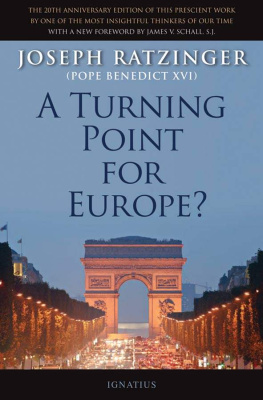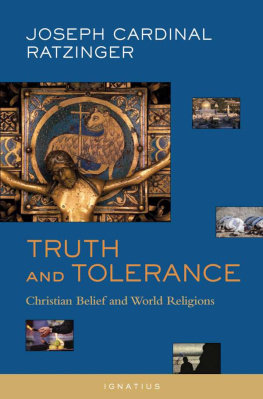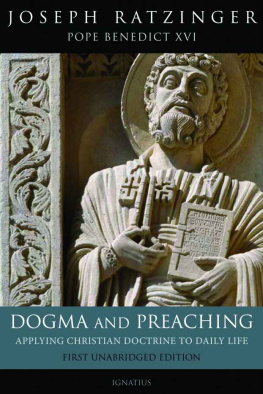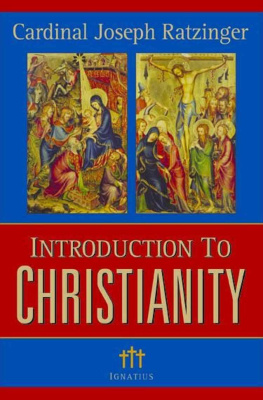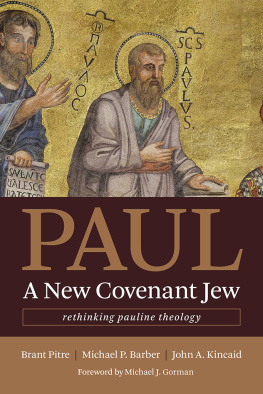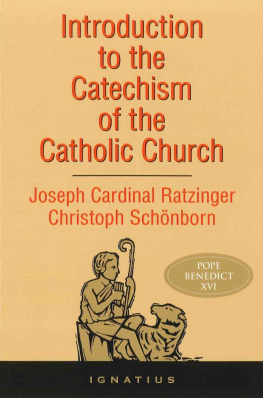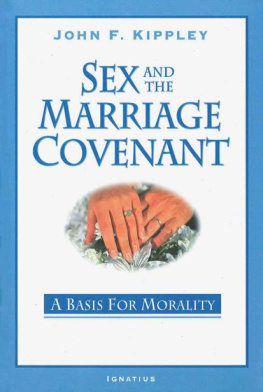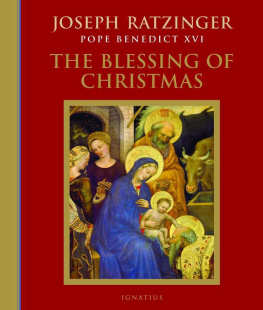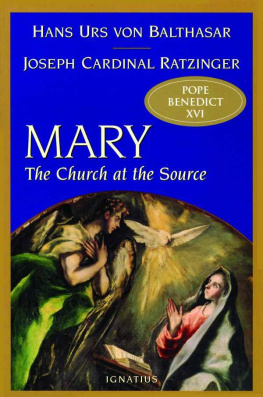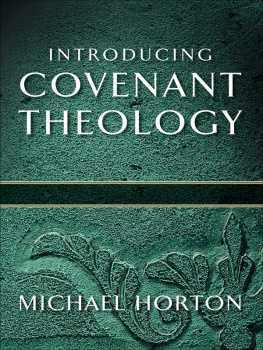Many ReligionsOne Covenant
JOSEPH CARDINAL RATZINGER
Many Religions
One Covenant
~
Israel, the Church,
and the World
TRANSLATED BY GRAHAM HARRISON
WITH A FOREWORD
BY SCOTT HAHN
IGNATIUS PRESS SAN FRANCISCO
Title of the German original:
Die Vielfalt der Religionen
und der Eine Bund 1998 Verlag Urfeld GmbH, Hagen
Cover photograph:
Dome of the Rock and Western Wall
CORBIS / David H. Wells
Cover design by Roxanne Mei Lum
1999 Ignatius Press, San Francisco
All rights reserved
ISBN 0-89870-753-3 (PB)
ISBN 978-1-68149-324-4 (EB)
Library of Congress catalogue number 99-73009
Printed in the United States of America
CONTENTS
Their Relation and Mission, according to the
1992 Catechism of the Catholic Church
(Translation by Fr. John Rock)
The mission of reconciliation
Reconciliation without abandoning the Christian faith ?
The presentation in the Catechism of the Catholic Church
Jesus mission: To unite Jews and pagans
Abrahams history is to be the history of all
Salvation is from the Jews
Jesus and Israel
Jesus fidelity to the Law
Fulfillment of the Torah through the Law of the Gospel
The unity between the good news of Jesus and the message of Sinai
The interrelation of both Testaments
The Torah as something integral
Jesus lives entirely under the Law of Israelas mediator of the universality of God
The conflict that ended on the Cross
Christian hope as the continuation of the hope of Abraham
No collective Jewish guilt
All sinners were the authors of Christs Passion
The drama of human sin and divine love
A glance at the common mission of Jews and Christians in relation to the world
On the Theology of the Covenant
in the New Testament
Agreement or ordinance?
Gods free ordinance
The contractual act of a love story
What is the difference between the Old and the New Covenant ?
The covenant in Christ and the Mosaic covenant
The covenant with Noah, with Abraham, and with Jacob-Israel
Legal prescription and promise
A unity in tension: The one Covenant in the plurality of covenants
The new unity of covenant ideas
The Sinai covenant heightened to a staggering realism
A new relationship with God
Covenant renewal in its highest possible form
The New Covenant established by God is itself present in the faith of Israel
Covenant renewal is not superfluous in the New Covenant
Two central questions
The irrevocable gift of friendship
The inner continuity of salvation history
Jesus the Messiah; the Torah of the Messiah
God binds himself to partnership
Binding himself even as far as the Cross
The God of the Bible is a God-in-relationship
Covenant as Gods self-revelation, the radiance of his countenance
Homily for the 19th Sunday in Year B, 1997
Fire from heaven
The flame of Horeb
The God who is poor
The new manna
God has become our bread
Be imitators of God!
The miracle of the manna made concrete
IV. THE DIALOGUE OF THE RELIGIONS
AND THE RELATIONSHIP BETWEEN
JUDAISM AND CHRISTIANITY
Religion no longer defined by its positive content
The divine, personal or non-personal
The cosmos no longer has anything to do with God
Salvation lies outside the world
Faith in God cannot dispense with a truth whose substance can be articulated
A short circuit
Lucifers most subtle temptation
Through Jesus the God of Israel has become the God of all the nations of the world
Jesus: Gods Son and Servant
Faith, hope, and love and the three dimensions of time
The Churchs messianic expectation
The mystical dimension of the Christian faith
The cloud of mystery
No renunciation of truth
Criticism of ones own religion
Proclamation of the gospel as a dialogical process
FOREWORD
by Scott Hahn
This book is a majestic bridge, fashioned by a master builder.
In Many ReligionsOne Covenant , Cardinal Joseph Ratzinger spans the deep divides in modern Catholic scholarship to present a compelling study in biblical theology, modern in its concerns yet classical in its breadth. It is his classical mastery, his ressourcement , that enables the Cardinal to build a bridge.
There can be no doubt that contemporary theology needs a bridge. Following the trend in secular academia, theology has fragmented into many isolated disciplines, each working in isolation from all the othersthe condition Jacques Barzun describes as specialism. Thus, dogmatic theologians often assume they have nothing to learn from biblical scholars. Exegetes, for their part, give scant consideration to the insights of systematic and dogmatic theologians. To many scholars, these disciplines are almost contradictory: doctrine is the opposite of Scripture.
Yet, amid the many varieties of theological experience, the author of this volume sees a profound unity. His synthesis will, perhaps, strike readers as novel; but it is actually a recovery of the great Catholic tradition, not only of the Scholastics and the Fathers, but of the Apostles themselves.
For, though the divisions are deep, they are not very old. They reach back, rather, to the aftermath of the Protestant Reformation. Whenever heresies arise, the Church must treat dogma in a way that does not give due proportion to the whole truth. Instead, theologians must emphasize precisely the points that heretics deny. For example, because the Protestant reformers emphasized faith sometimes at the expense of works, post-Reformation Catholic theology has tended to emphasize works more than faith. Because Protestants preached Scripture alone apart from tradition, Catholics have had to emphasize sacred tradition to a greater degree than before.
All this was necessary, in a remedial way. Yet its lingering effect has been to produce a theology that majors in relatively minor points. After all, tradition itself teaches the primacy of Scripture, and Catholic authorities from Saint Paul onward have taught the priority of faith over works. In classical theology, faith and works, Scripture and tradition, all receive their due, because all belong to one essential reality, whose archetypal expression is in the Word of God.
Thus, the revealed Word is, as it were, the support for every length of the Cardinals theological bridge. Indeed, the Bible is the model he chooses for his theology, a fact he has acknowledged in his Principles of Catholic Theology : The writers of Holy Scripture speak as themselves, as men, and yet, precisely in doing so, they are theo-logoi , those through whom God as subject, as the word that speaks itself, enters history.... [Thus] the Bible becomes the model of all theology.
Yet, more than a mere blueprint, the Bible is theologys singular authority. Later in the same work, Cardinal Ratzinger adds: The normative theologians are the authors of Holy Scripture (emphasis mine). And finally he addresses the Bible as the fulfillment of theology: Scripture alone is theology in the fullest sense of the word, because it truly has God as its subject; it does not just speak of him but is his own speech.
Neither does he make apologies, as a dogmatic theologian, for such an overwhelming biblical emphasis. Like his patristic and scholastic ancestors, he transcends academic overspecialization. Far from being opposites, doctrine and Scripture are irreducibly united in Cardinal Ratzingers work. He has gone so far as to say that dogma is by definition nothing other than an interpretation of Scripture. His insight has been confirmed by the most august group of his fellow theologians, the International Theological Commission, in its 1989 document On the Interpretation of Dogmas : In the dogma of the Church, one is thus concerned with the correct interpretation of the Scriptures. Dogma, then, is the Churchs infallible exegesis, and dogmatic theology is a reflection upon that work.
Next page

